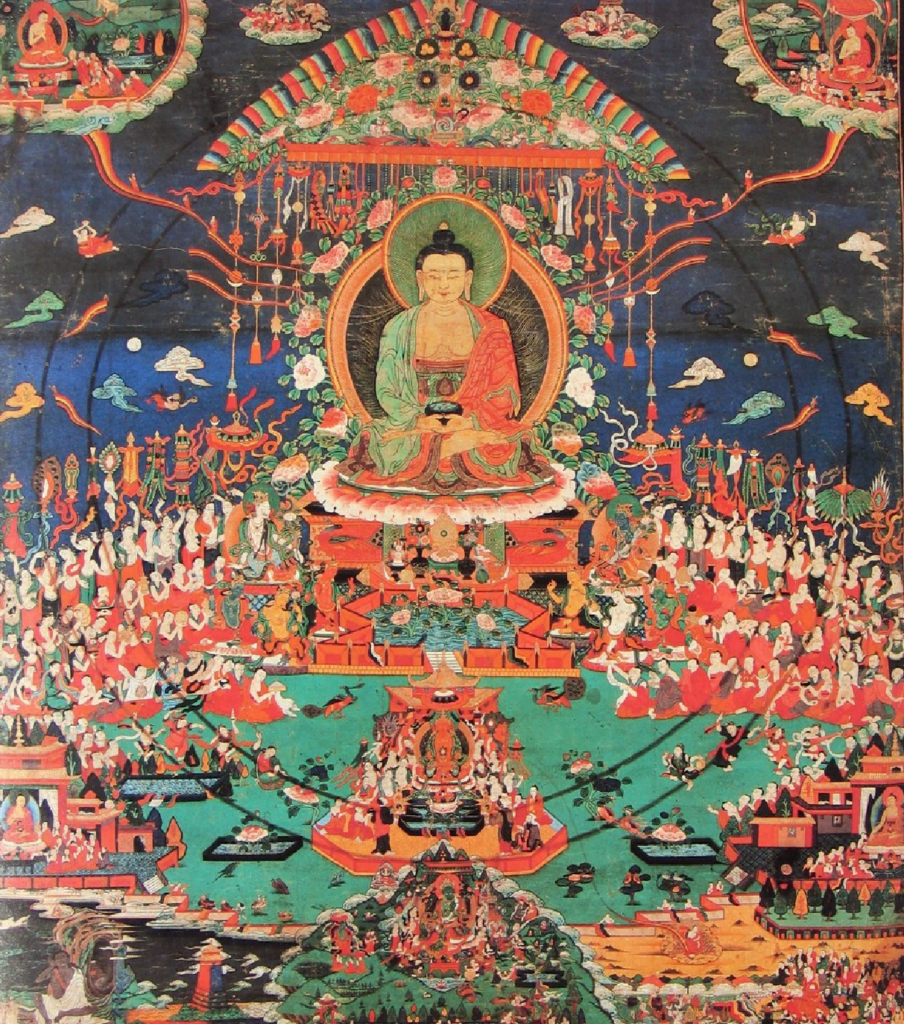The pure land of great bliss, or delight, Sukhāvatī, is said to be the buddha-field of the Buddha Amitābha and is located in the western direction.
In the discourse titled The Display of the Pure Land of Sukhāvatī, set in the Jeta Grove of Śrāvastī, the Buddha explained to an audience of bodhisattvas and arhats about the land of Sukhāvatī:
“Śāriputra, if you go from this buddha realm past one hundred thousand myriad buddha realms toward the western direction, there is a world known as Sukhāvatī. In that place the tathāgata, the arhat, the perfectly and fully enlightened buddha known as Amitāyus, dwells, lives, and abides, teaching the Dharma.
“Now what do you think, Śāriputra, why is that world called ‘Sukhāvatī’?
“Śāriputra, in the Sukhāvatī world, sentient beings experience neither physical pain nor mental suffering and the causes for their happiness are limitless. For this reason, this world is called Sukhāvatī.”
Āryasukhāvatīvyūhanāmamahāyānasūtra, The Noble Mahāyāna Sūtra “The Display of the Pure Land of Sukhāvatī”, 1.3.
This particular text is known as the “shorter” Sukhāvatī sutra, but there are two companion texts on the same theme. The first is a longer and more elaborate text translated as The Array of Amitābha. The third text is only found now in Chinese translation and is known as The Amitāyus Meditation Sūtra.
The extant Tibetan translation dates from the 8th or 9th century, but earlier Chinese recensions (3rd-5th centuries) spread rapidly from China to Korea, Japan, and Vietnam. The popularity of the sutra was crucial in the formation of Pure Land schools in East Asia.
The principal buddha presiding over Sukhāvatī is known by two names. These are the sambhogakāya form of Amitāyus (Immeasureable or Boundless Life) and the nirmāṇakāya Amitābha (Immeasureable or Boundless Light).
In the sutra, the buddha explained to his audience that it was not enough to merely know about the existence of this pure land. He instructed them:
“…sons and daughters of good family should completely dedicate all roots of virtue in a respectful manner to be born in that buddha realm. Why? Because by doing so, they will be able to meet holy beings similar to themselves. Śāriputra, one cannot take birth in the realm of the Bhagavān Tathāgata Amitāyus merely with minimal roots of virtue.
“Śāriputra, if those sons and daughters of good family hear the name of the Bhagavān Tathāgata Amitāyus and keep it in mind unwaveringly for one, two, three, four, five, six, or seven nights, when the hour of their death arrives, they will depart in an undeluded state. After they have passed away, the Tathāgata Amitābha will stand before them, entirely surrounded by a śrāvaka assembly and honored by a congregation of bodhisattvas. These sons and daughters of good family will be born in the Sukhāvatī world, the buddha realm of the Bhagavān Tathāgata Amitābha. Therefore, Śāriputra, having seen its real point, sons and daughters of good family, I declare, ought to respectfully make prayers to reach that buddha realm.
Āryasukhāvatīvyūhanāmamahāyānasūtra, The Noble Mahāyāna Sūtra “The Display of the Pure Land of Sukhāvatī”, 1.10-1.11.
Tibetan masters throughout the centuries have followed this advice, and have composed a number of moving supplication prayers for rebirth in the pure land. The great Terton Chokgyur Dechen Lingpa revealed an aspiration prayer for rebirth in Sukhāvatī from among the Thirteen Oral Instructions at Blazing Jewel at Tsiké Drak in Tibet.
An important reason to aspire to rebirth in Sukhāvatī is that sentient beings there are surrounded by the sights and sounds of Dharma. It is said to be an ideal place to mature one’s practice without any fear of suffering.



